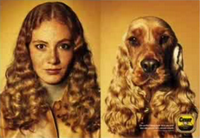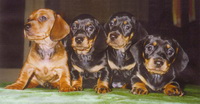How dogs are trained
 The behavior of the animal is influenced by hereditary factors and learning. The greater the proportion of behavioral reactions that the training component takes, the easier it is to manage your dog.
The behavior of the animal is influenced by hereditary factors and learning. The greater the proportion of behavioral reactions that the training component takes, the easier it is to manage your dog.
Traditionally, the physiological bases of training are considered from the standpoint of the conditionally reflex theory of IP Pavlov. In accordance with it, all forms of animal behavior can be explained on the basis of the principle of the reflex nervous connection. At the same time, the essence of training consists in developing and using the necessary conditioned reflexes in the work. According to this principle, a previously neutral irritant — for example, the Sit! Command, combined many times with the forced landing of a dog — acquires the value of a conditioned stimulus, triggering an arc of a conditioned reflex and causing the required actions of the animal. Without going into the subtleties of physiology, I will say that the arc of the conditioned reflex is the closure of the temporal relationship between the auditory and motor centers of the brain. The reflex is considered to be fixed if the dog, without hesitation, sits in the required position, barely hearing a familiar sound signal.
Ethologists claim that dogs learn from each other, from their owner and his environment. As the wise proverb states: “A bad example is contagious.” Therefore, make sure that the lessons your pet learns passively are positive. It is known, for example, that in a society of a bad breed a puppy “forgets” the teams and “does not hear” the owner, behaving to match an uncontrollable relative. Young dogs are particularly prone to learning by observing and mimicking. Experienced trainers often take a well-trained dog with them to class, which by its actions provokes the puppy to carry out commands. So, watching as an adult dog overcomes the barrier and gets a treat for it, the puppy learns this behavior on its own much faster than those who do not have a four-way “teacher.”
However, the dog gets most of its life experience using trial and error. The dog tries to repeat the action, which entails the satisfaction of need, again and again, and tries to avoid the action that caused unpleasant sensations. The trial and error method is widely used in dog training, providing purposeful upbringing of an animal for performing a particular activity (see “The First Days of a Puppy in a New House”, “Primary Education of a Puppy”). In total, such training includes the manipulation of the system of penalties and rewards. Positive reinforcement of the desired action from the dog can increase the likelihood that this action will play it over and over again. Food, toys, physical caress, verbal praise and attention from the owner are used as positive reinforcement.
Conditioned reflexes are developed faster if the dog makes the necessary movements itself, and they are supported by the trainer in time. You can call a dog passive movements – for example, forcing her to sit down by pressing in the lumbar region. But the reflex to the word: “Sit!” Is formed faster if you create such conditions so that the dog begins to sit down itself. The “contactless” way of teaching this team is widely known, when the trainer forces the animal to adopt the desired position, holding a piece of food over the puppy’s head. In this case, the dog independently, “on free will,” performs the actions that are required of it, and as a result learns much more willingly and actively.
When using food as a positive reinforcement, give as little as possible a piece – for example, a cube of meat the size of a centimeter or a granule of dry food. If your pet especially loves food, you can try to cut even smaller pieces. The trainers claim that, getting a treat in the process of teaching the teams, the dog should not be distracted by chewing, grabbing a large piece. For puppies aged 8–9 months, the use of small portions of delicacy means a greater number of reinforcements during one training session with intensive training. It is important to accurately recognize the moment when you should reward the dog with a treat. For example, if, when practicing the Sit! Command, the puppy managed to jump even before he received a tasty slice, it means that you were late with reinforcements and as a result you encouraged jumping from the spot, but not sitting. When using the taste-supportive method in primary education, reinforce the desired behavior each time it manifests. However, after the dog has mastered the trick, the use of the delicacy becomes periodic and eventually should disappear.
Some experts argue that the choice of food reward depends on the difficulty of the team performed. For example, if a dog “cleanly” overcame a difficult obstacle, then he should get a bigger piece and your sincere praise. K. Payer says that the best result requires an appropriate reward – ten times more than the usual reinforcement, which is a pleasant surprise for the dog.



